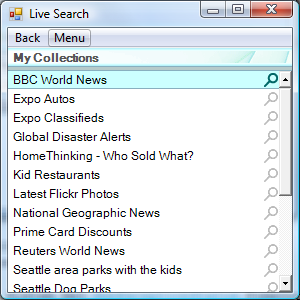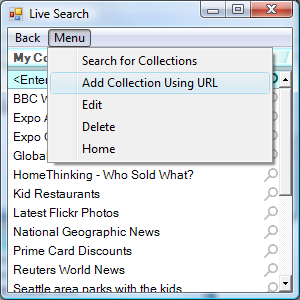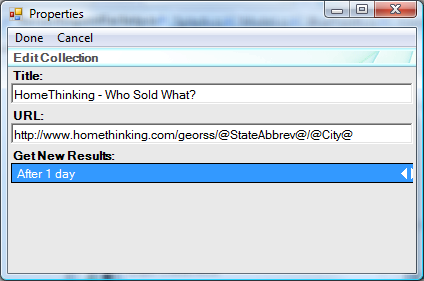Hopefully by now you all have v3.0 of the Live Search client, and are enjoying the new features (web search, weather, and collections). I’d like to talk about collections in this post, but first it is worth mentioning a couple of changes in this version that are less obvious, and overcome limitations I have blogged about in the past:
- we now have Outlook contact integration. From Outlook contacts you can select the “Show on Map” menu option to map a contact. Google Maps contacts integration is still broken, but we can’t let that hold us back any longer; we gave them nearly a year as well as explicit instructions on what their bug was; if they can’t get their house in order with all that then too bad for them. If you do want to use both GMM and Live Search, then install GMM last. Their bug will cause problems with any other software that installs menu extensions that is installed after them; if the other apps are well-behaved then you can install them before GMM and you should be okay.
- we have put back the ability to enter addresses in the search box. We have a better geocoder now on the back end and are more confident that you will get the results you want when doing this.
Okay, on to GeoRSS. This was my pet feature that I originally built in September 2006 and it finally got shipped (and if you say ‘about time!’ then I have the names of the two people who kept trying to kill this to give to you; go blame them ;-))
The Collections feature is built around Virtual Earth collections, to make it easier for people who don’t know/care about GeoRSS to use the feature and get some value out of it. For the more hard-core, you can enter GeoRSS URLs directly:
The actual collections/feeds are stored in the application directory in a file called feeds.xml. You may find it instructive to look at that file.
The cool thing about the URLs is that they can contain metatokens, which will expand to location-specific values:
For example, the URL above:
http://www.homethinking.com/georss/@StateAbbrev@/@City@
has two such metatokens, namely @StateAbbrev@ and @City@. These will get converted into appropriate values based on your search location before the feed is fetched.
The supported metatokens are:
- @StateName@ - state name, e.g. “Washington”
- @StateAbbrev@ - state name abbrevaited form e.g. “WA” (outside the USA this will be the same as @StateName@)
- @City@ - city name
- @Zip@ - zip or postal code
- @Location@ - the full text shown in the main view for the current location
- @Latitude@, @Longitude@
- @StartLocation@, @StartLatitude@, @StartLongitude@, @EndLocation@, @EndLatitude@, @EndLongitude@ - similar to @Location@ etc but for the start and end points of the last route you calculated. The idea being you could pass these up to a transit service to get, for example, a bus schedule
- @MyLatitude@, @MyLongitude@, @MyLocationTime@ - the location and time (in UTC) of the last GPS fix
In a later post I’ll describe the GeoRSS schema that the client understands (it is a hybrid of GeoRSS, some Yahoo extensions, some KML and some OASIS xADR address stuff). For now I’ll just mention one interesting extension, namely pushpinurl, which can point to a .ico file. This file will be used as the pushpin icon on the map for that result. This can allow you to make custom pushpins.


